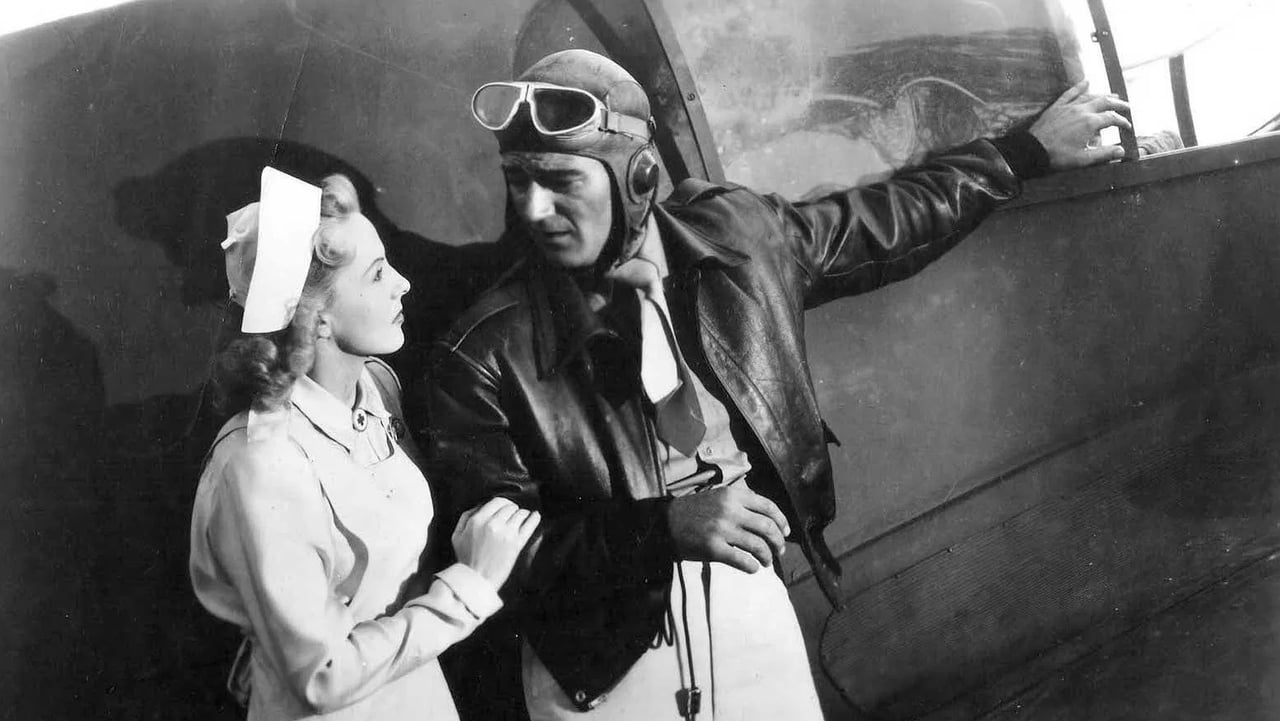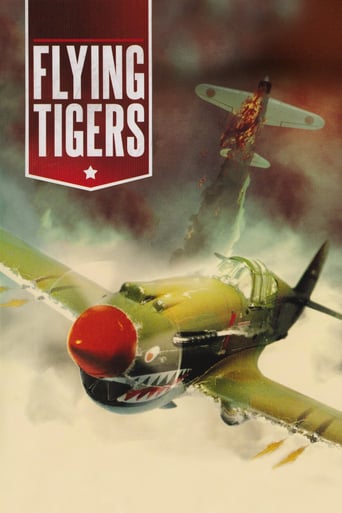GurlyIamBeach
Instant Favorite.
Beystiman
It's fun, it's light, [but] it has a hard time when its tries to get heavy.
ChampDavSlim
The acting is good, and the firecracker script has some excellent ideas.
Casey Duggan
It’s sentimental, ridiculously long and only occasionally funny
mark.waltz
While the planes these American war heroes supposedly have the face and teeth of tigers painted on them, it is very apparent that they look more like sharks. As these military men of the United States protecting the Chinese from invasions of the Japanese, they are involved in combat even before the attack on Pearl Harbor. John Wayne is the jovial commander of the base, in love with nurse Anna Lee (of "General Hospital" fame) and dealing with a brash newcomer (John Carroll) whose arrogant presence is upsetting the other men. Carroll can't be described as a team player; In fact, he takes it upon himself to make his own rules without regards to the consequences. In spite of all that, Wayne remains on his side even though he's breaking a lot of rules. But when one of Wayne's men is killed (after being grounded due to issues regarding a lack of depth perception) while covering for Carroll (out on a dinner date with Lee), the Duke has had enough, and prepares to send Carroll back. Then, December 7th occurs, and the mission that they were previously on becomes more complicated.Not much different than other war stories about the Pacific, but lacking in some of the clichés that made others trite and stereotypical. Wayne is extremely likable, Lee an absolute delight, and the Chinese children she is taking care of totally adorable. Her description of the plight they went through to get through to her is very moving. Carroll's performance is a mix of arrogance, tenderness and insecurity, his cockiness obviously hiding a lack of self-esteem and ability to be part of an important team. The combat sequences are well filmed with some bloodiness thrown in to make them more realistic. This helps make the "Why We Fight" message of the film seem less obvious and results in a genuine crowd pleaser.
Neil Doyle
FLYING TIGERS, made on a tight budget for Republic Studios, has JOHN WAYNE doing his standard hero role with ease and skill as he copes with a squadron of American men volunteering to shoot down Japanese planes during the early days of WWII. And contrary to another's comments, that's not Harry Truman declaring war on the Japanese, it's Franklin D. Roosevelt, heard in his famous speech to Congress wherein he invokes that "day of infamy" phrase.If this were an MGM film, it would have been a perfect vehicle for SPENCER TRACY (in Wayne's role) and CLARK GABLE (in the JOHN CARROLL part of a cocky flyer). Carroll breezily handles the role of Jason, Wayne's old service buddy who shows up at the outpost in China so he can shoot down the Japanese for $500 per downed aircraft and makes no bones about it. His cavalier attitude is a turnoff for the men in the squad, so we know he's going to have to redeem himself in everyone's eyes by becoming a hero before the last reel is over.It's a clichéd story, done before in films like ONLY ANGELS HAVE WINGS, even the part about the disabled man whose eyesight bans him from flying but nevertheless must prove himself when the chips are down and he gets the chance to fly because Carroll doesn't show up in time. These and other plot devices seem borrowed from the Howard Hawks film, whether intentionally or not.But it serves as good, solid entertainment for John Wayne fans, despite the low-budget production values because all of the aerial sequences are well filmed with special effects that make the action as realistic as possible, even when some of the footage appears to be taken from actual stock scenes of dogfights.Victor Young's score is a solid plus, and the performances are adequate with ANNA LEE as a charming nurse for Wayne's love interest and GORDON JONES as Carroll's sidekick, with MAE CLARK, TOM NEAL and David BRUCE in minor roles.Carroll's role is played in such a way that he reminded me of a poor man's Clark Gable--the same cocky charm and arrogance that Gable would have brought to the role.For fans of WWII war films, this one fills the bill nicely.
Bill Slocum
John Wayne's first war film was one of his best, a solid actioner with Wayne giving great presence as the leader of a fighter squadron doing battle against the Japanese invader over the skies of China in the dark days before the U.S. entry into World War II.Wayne plays Jim "Pappy" Gordon, a variation on the many flinty-commander-with-heart-of-gold characters he would play in films to follow like "Sands Of Iwo Jima" and "Fighting Seabees." Gordon is less flinty than most of them, maybe because his men are volunteers or maybe because his girlfriend Brooke (Anna Lee) is stationed on the same airbase. While the Japanese take their toll on his men, Gordon's toughest job may be keeping peace in his squadron when smug gloryhog Woody Jason (John Carroll) arrives.When I first saw "Flying Tigers" as a boy, the on-screen gore made the strongest impression. In those days, before pay television, it was something to see a Japanese pilot grab his face, blood oozing through his fingers. Times have changed, of course, but one is still impressed by the well-rendered dogfight sequences, for which Ted Lydecker was nominated for an Oscar. Though it's troubling to be entertained by what amounts to real images of people getting killed, director David Miller manages to incorporate actual combat footage very well into battle sequences that alternate with Lydecker miniature work and shots of actors in their cockpits, better than the more acclaimed director Nicholas Ray later did in another Wayne air war film, "Flying Leathernecks.""Flying Tigers" contains one key historical inaccuracy: While assembled in the months before Pearl Harbor, the Tigers didn't see action until December 20, 1941. This is an important caveat, but the inaccuracy allows for one of the very first and best examples of that classic movie cliché, where a dramatic scene ends with a glimpse of a desk calendar showing the date "Dec. 7." The scene that follows is one of those Wayne moments that resonated especially in theaters in 1942 and still packs a punch now: Pappy alone by a radio, standing expressionless while a cigarette smolders in his fingers, listening to President Roosevelt declare war.Neither Wayne's iconographic stature or final victory against the Japanese were sure things when "Flying Tigers" came out in 1942; we tend to take more for granted and give films like this less credit. Wayne was 35 and not a real soldier, yet he came to define the war effort for many. Judging from the way some comments here attack him as a straw dog for present U.S. war policy in Iraq, Wayne's potency as a symbol remains undimmed.Climbing off his P-40 after an early mission, Wayne is shown a row of bullet holes on his fuselage. "Termites," he says laconically, before striding away.I give a lot of credit here to Miller, who knew what he had in Wayne before anyone else did, and uses the actor's terse authority to great effect. Miller was making propaganda, yes, but effectively and sensitively: We see Chinese children victimized by war, including one shot of a wounded child crying after a bombing clearly modeled on a famous war photo of the period. Unlike other wartime films which went heavy on ethnic stereotyping, the Japanese are seen as skilled, ruthless adversaries who require resolve to face down.The film does lose altitude at the end, when Wayne goes off on a hare-brained bombing mission and Carroll has a "why-we-fight" epiphany that rings rather hollow. Maybe it's because he's playing a heel, but I find Carroll hard to take, with his Clark Gable mannerisms and the way he seems to always play to the camera rather than the other actors. There's also a little too much melodrama between Wayne and Lee that feels out of place in a war film.But "Flying Tigers" has weathered the years better than most films of its kind, and is a historic landmark both for its effective action scenes and its pioneering use of Wayne as cultural touchstone. More than 60 years later, it still packs a punch.
btillman63
Several friends of mine flew with the AVG. One of them who attended the premiere (c. October '42) recalls that he and a couple other Tigers were so embarrassed by the film that they were caught sneaking out of the theater.However, the loathing of John Wayne contained in other reviews on this site demonstrates a total lack of objectivity. Wayne was 35 at the time of Pearl Harbor, and not even his friendship with then-Cdr. John Ford could get him accepted for military service. (according to one bio, his distinctive walk resulted from a football injury.) On one tour of the Pacific, Wayne got dead drunk with some fighter pilots in New Guinea. They placed his inert form on a cot and carried it into the middle of the compound and allowed him to awake with a hangover: stark naked. He rolled over and went back to sleep...Whatever anybody thinks of Wayne or the Vietnam War, he was still visiting troops in-country at age 63.

